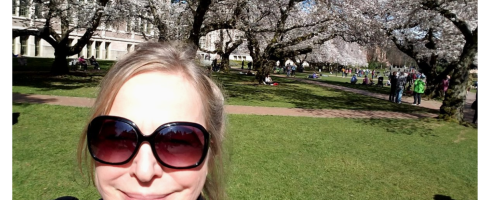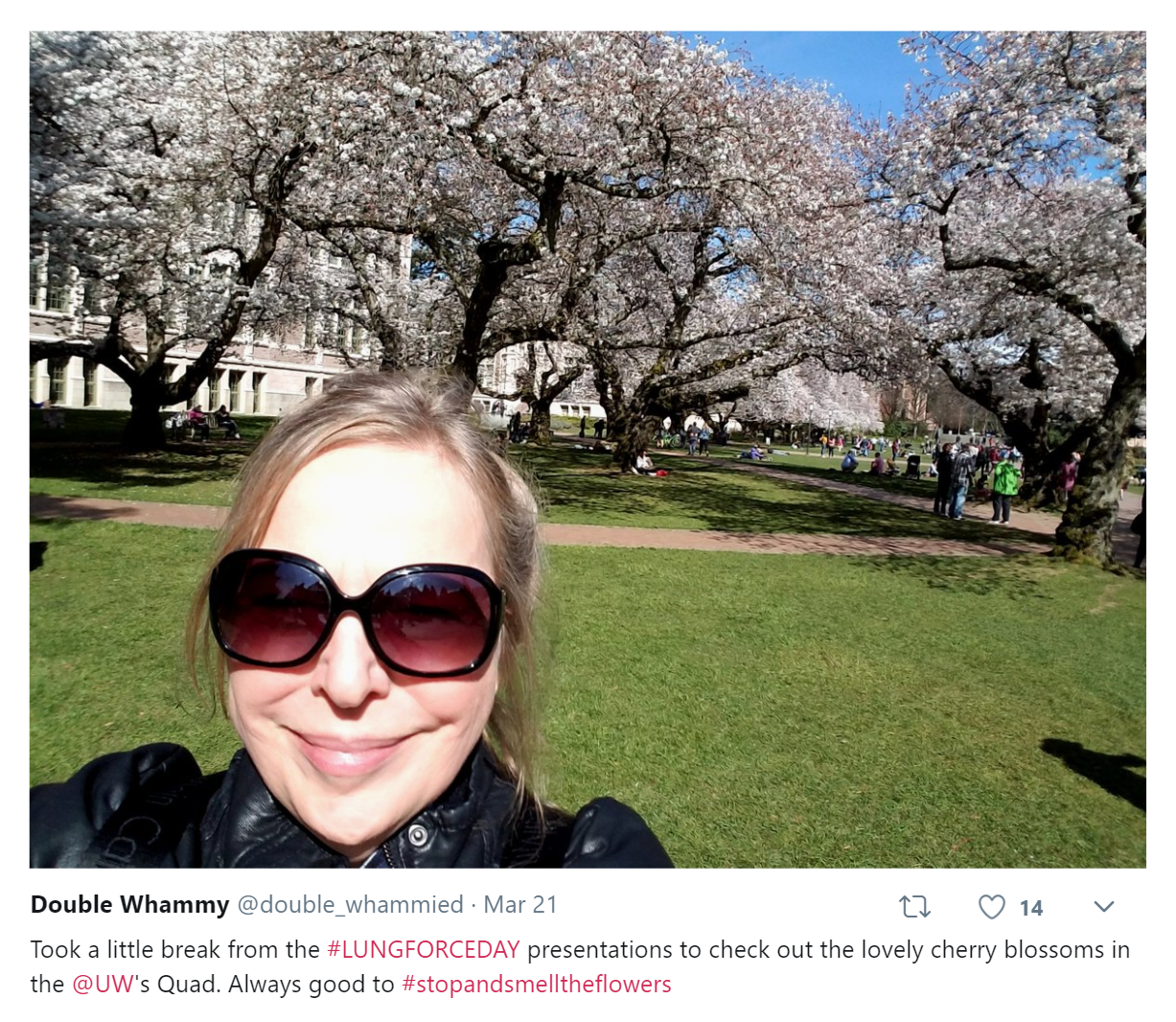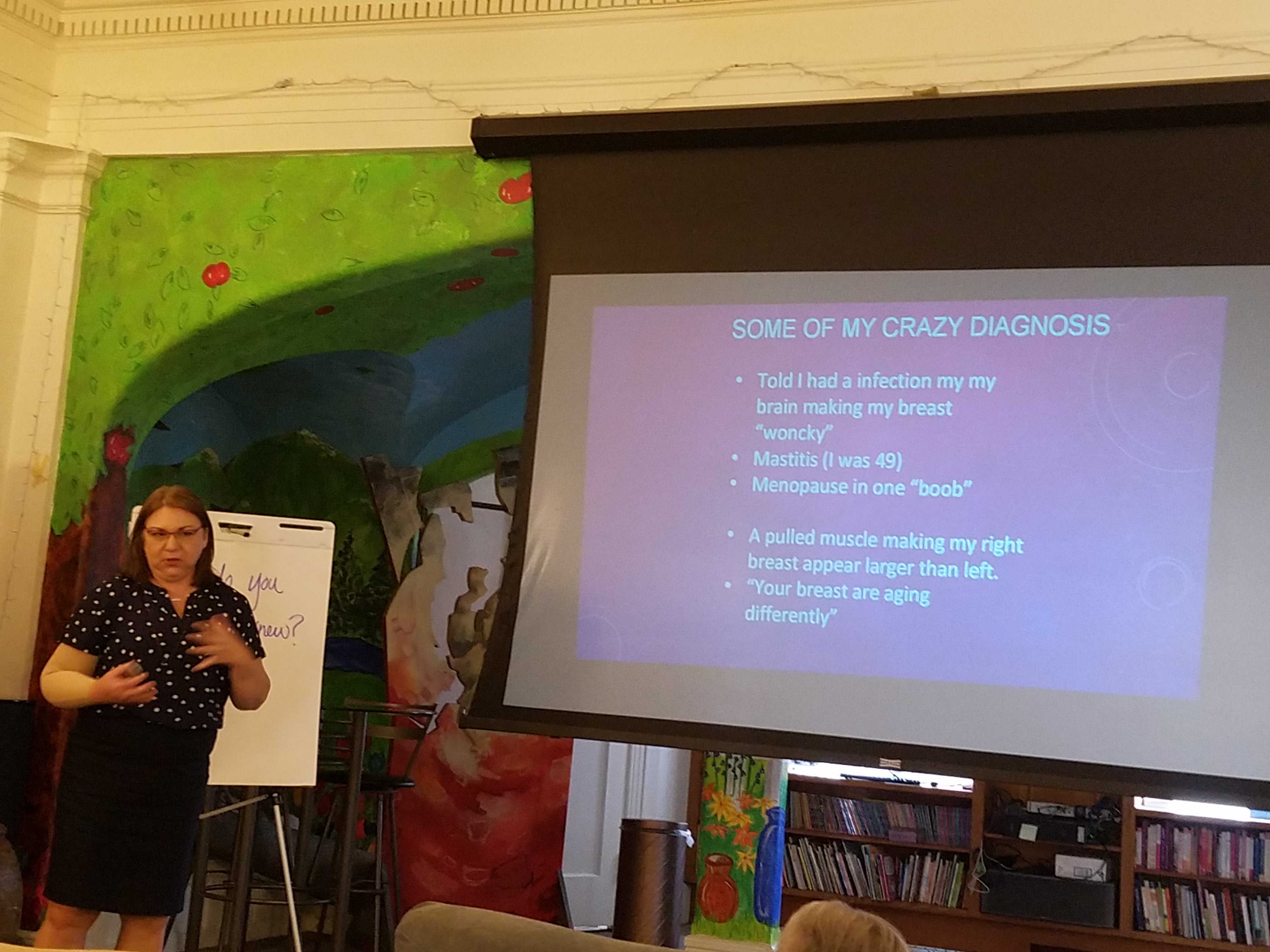 Ever get a question that sticks with you, that you can’t shake, that you keep ruminating on until you finally get an answer? My niggling question came in via email in the summer of 2015. The person emailing had just read a story I’d written the year before, shortly after I started working at Fred Hutch as a science writer and cancer whisperer. It was called Living with Stage 4: The breast cancer no one understands and featured a couple of patient advocates / friends, Teri Pollastro, still living large, and Jody Schoger, sadly gone.
Ever get a question that sticks with you, that you can’t shake, that you keep ruminating on until you finally get an answer? My niggling question came in via email in the summer of 2015. The person emailing had just read a story I’d written the year before, shortly after I started working at Fred Hutch as a science writer and cancer whisperer. It was called Living with Stage 4: The breast cancer no one understands and featured a couple of patient advocates / friends, Teri Pollastro, still living large, and Jody Schoger, sadly gone.
The question from my reader had to do with a statistic I’d used in this passage: “While treatable, metastatic breast cancer (MBC) is incurable, between 20 and 30 percent of women with early stage breast cancer go on to develop MBC.”
“Can you please tell me where you got the statistic of 20-30%?”
I wrote back the next day, explaining that I’d gotten the stat from 2013 Metastatic Breast Cancer Alliance Landscape report (you can peruse it here). And pasted in the original paragraph from the report: The actual number of new cases of MBC diagnosed each year is unknown. This is because SEER* only records the 5% of newly diagnosed breast cancer patients who have de novo MBC. However, most patients with MBC were first diagnosed at earlier stages of breast cancer that then recurs, months to years later. An estimated 20% to 30% of early stage breast cancer patients will develop MBC sooner or later. The SEER registries do not capture this much larger percentage. As a result, the actual annual incidence of MBC remains unknown.* Surveillance, Epidemiology and End Results program
This was when I first started to clue into the whole SEER data gap issue. The lack of recurrence data was news to me at that point – I was still reeling from treatment, dealing with recon and bootstrapping my way into the world of science and academic cancer research. But it was NOT news to my correspondent, who wrote back to emphasize how nobody really knew the answer, whether it was 5% or 50%, because it simply wasn’t tracked. Naturally, I wanted to write about this. Like immediately. I even replied to the person at 2:15 in the morning on my birthday (!) to tell them as much.
Do I know how to party or what? 😉
You get the problem, though. How could the country’s oldest, most well-respected cancer registry – the premier statistical clearinghouse for cancer information here in the U.S. – not have something as basic as the answer to a question like, “Soooo, roughly how many of us saps with early stage cancer go on to get mets?”
Digging in, I found others were way ahead of me, as usual, particularly Katherine O’Brien and the Metastatic Breast Cancer Alliance who launched a petition in 2016 asking SEER to “Start Counting ALL People Living With Metastatic Breast Cancer.” Katherine was hip to this issue in 2009; I’m sure there are many others who’ve been trying to change it longer than that, including researchers and healthcare providers. My email buddy was one of these people. They wrote back once more, and as mentioned above, their question – a request, really – has stuck with me ever since.
“Bottom line is that nobody tracks the data. The NCI could very easily track it … They track so many little pieces of data … that this would be a piece of cake. If there is anything you can do to help force the NCI or someone else to track those who start out at earlier stages and progress to stage 4, you could be doing a great service.”
As a lowly science writer employed by an NCI-designated comprehensive cancer research center (an admittedly conflicted position), I can’t realistically “help force the NCI” or any federal agency do anything. But like any patient advocate, I can ask questions and have conversations and make connections and talk and tweet about cockamamie cancer issues like this; I can write stories and try to bring awareness to the issue. I can follow the story to see where it goes. And that’s what I’ve tried to do over the last few years.
And happily, I’m seeing change. Maybe even a sea change.
For instance, Dr. Ruth Etzioni, a Hutch biostatistician and modeler who uses SEER registry data to inform ACS and USPSTF screening guidelines, immediately put this on her Scientist Things To Do list. She applied for and got an NCI grant to create, validate and implement a “scalable, automated approach for identifying cancer recurrence.” Another NCI grant and a bit of biostatistical magic helped her and her collaborators pull out key numbers (see below) that give us a much clearer picture of how many early-stager BC patients develop mets. For a breakdown of the findings, check out this Komen Puget Sound FB Live from the 2018 NWMBC Conference. It’s a great panel featuring with Dr. Corrie Painter of the MBC Project and other living legends. Ruth presents her MBC stats about 27 minutes in. Read more on her data mining methods here.
BREAST CANCER RECURRENCE RATES
- 20% progress in 20 years. 20% of people diagnosed w/ early-stage breast cancer (stage 1 to 3) will go on to develop metastatic disease within 20 years.
- 17% progress in 15 years. 17% of early-stagers become metsters within 15 years.
- 20%+ progress in 20+ years. Over a longer time period, the 20% figure will increase.
- Under 15 years, “very variable.” Within 15 years, it depends on the patient’s age, stage, hormone receptor status, etc.
Science is slow; everything takes years. And sometimes reporting is like that, too. But finally, here are some solid scientific numbers on metastatic breast cancer recurrence. It’s not 5%. It’s not 50%. It’s like 20-30%. It needs to be a 0%, of course, but now at least we know.
And that’s just the start. I was finally able to write that SEER story and am happy to report the NCI is currently working to improve the registry. Thanks to a score of data scientists and biostatisticians and oncologists and registrars and patient advocates and others, they’re finally trying to connect those “many little pieces of data” my email buddy mentioned all those years ago.
This is a long post, and cheers to you if you’re still reading. I guess I just I wanted to share the backstory on this story because it’s not just about hard to capture data. It’s not just about niggling questions or intellectual curiosity. It’s about the fact that not having this information, not even making an effort to collect this information, has left metastatic patients feeling uncounted, unheard, unseen, uncared for. And that’s pretty awful. Year after year, I’ve seen the tweets and posts from the newly diagnosed and those fresh to advocacy as they learn the NCI doesn’t track metastatic recurrence. They’re shocked, sad, outraged, full of disbelief. It’s like a slap in the face. How could they not count us?
 I guess I’m writing this post for them. I want people in the cancer community to to know there’s been some progress. The NCI is actively working to bring the SEER registry and its infrastructure into the 21st century so we can finally address these burning cancer questions – and who knows, maybe stumble onto a therapeutic insight or three.
I guess I’m writing this post for them. I want people in the cancer community to to know there’s been some progress. The NCI is actively working to bring the SEER registry and its infrastructure into the 21st century so we can finally address these burning cancer questions – and who knows, maybe stumble onto a therapeutic insight or three.
From my conversations with people at the NCI and with researchers like Dr. Steve Schwartz, who maintains the Hutch-based Puget Sound registry and is a cancer patient himself, it’s pretty obvious SEER and epidemiologists and others know this data’s been MIA for way too long. They know it has immense value; they want it as much as patients. Steve and Ruth even joined a couple of Zoom sessions with ACE (Advocates for Collaborative Education) and GRASP (Guiding Researchers and Advocates to Scientific Partnerships) to talk about registry data and field questions about the data gaps.
It’s a massive undertaking and it’s not going to happen overnight, but I’m grateful there is progress to report. I’m grateful that mets patients are being seen and heard and at long last counted. And I can’t wait to see how it all shakes out, because, of course, I’ll keep following the story. I’m kind of annoying like that.
Hope this piece offers you a little hope, especially if you happen to be a certain email correspondent of August 2015. As always, thanks for the read. Much love to all on this sunny April afternoon.
What’s a cancer registry? These large national databases track cancer trends, spotlight health disparities and improve patient care; new linkages allow for even more.
LINK: https://www.fredhutch.org/en/news/center-news/2021/03/cancer-registry.html




 Discovered a new Twitter tool that I’m geeking out about a little. It’s called ‘Moments’ and it lets you string a bunch of tweets together — yours and others’ — to create a short story. It’s a bit like Storify, which recently lost its battle with cancer … er … capitalism. RIP, brave fighter! ; )
Discovered a new Twitter tool that I’m geeking out about a little. It’s called ‘Moments’ and it lets you string a bunch of tweets together — yours and others’ — to create a short story. It’s a bit like Storify, which recently lost its battle with cancer … er … capitalism. RIP, brave fighter! ; )
 Here’s my
Here’s my 
 It’s been a busy few months in Cancer Advocacy Land and it’s going to get even busier as we head full on into spring. I’ll be lending my patient voice to a couple of Seattle conferences on cancer care cost, health equity/health disparities and policy in
It’s been a busy few months in Cancer Advocacy Land and it’s going to get even busier as we head full on into spring. I’ll be lending my patient voice to a couple of Seattle conferences on cancer care cost, health equity/health disparities and policy in  Also went to Portland mid-March for Komen Oregon and SW Washington’s
Also went to Portland mid-March for Komen Oregon and SW Washington’s  Big doins in the world of mets these days. And by mets, I mean metastatic breast cancer, not the baseball team. And by big doins, I mean the upcoming
Big doins in the world of mets these days. And by mets, I mean metastatic breast cancer, not the baseball team. And by big doins, I mean the upcoming